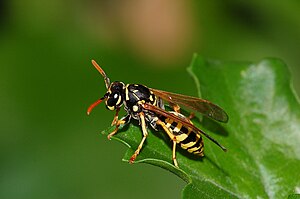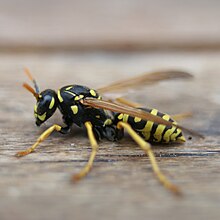Field wasps
| Field wasps | ||||||||||||
|---|---|---|---|---|---|---|---|---|---|---|---|---|

Gallic field wasp ( Polistes dominula ) |
||||||||||||
| Systematics | ||||||||||||
|
||||||||||||
| Scientific name | ||||||||||||
| Polistinae | ||||||||||||
| Lepeletier , 1836 |
The field wasps ( Polistinae) are a subfamily of the folded wasps (Vespidae). About 630 species are known worldwide. Most species live in the tropics and subtropics , only six species, all of which belong to the genus Polistes , also live in Central Europe.
Similarities with real wasps
Field wasps are quite similar in appearance and behavior to the real wasps (Vespinae). The Central European species (of the genus Polistes ) also have the typical black and yellow warning color , and they are eusocial in small peoples. Both subfamilies build nests out of a paper-like material made from chewed wood fibers . Therefore, they are referred to as paper wasps, unlike the Lehmwespen that their nests mainly with or in clay or loess build.
Nest building
When building nests, however, there are also significant differences to the real wasps:
- As with real wasps, the nest is usually founded by a single female (queen) ( haplometrotic ). Occasionally, however, the founding of nests by several females (queens) can also be observed ( pleometrotic ). Polygyny often occurs during nest care, so a colony can be cared for by several females (queens) (polygynous nests). Usually sister animals come together for this community care. Field wasps can distinguish familiar and unfamiliar conspecifics by features of the head. This was demonstrated by a series of tests with Polistes fuscatus .
- Honeycombs and colonies are significantly smaller than those of the more common and well-known real wasps.
- All wild wasp species build their combs at a slightly inclined vertical position and without a protective cover, the combs are always open and exposed.
The wasps attach their small combs to plants and other suitable substrates such as wood and stones with a central stem . The usually quite short stalk between the honeycomb and the substrate serves as a narrow point that is easy to defend against ants. Usually the nests are built in heat-favored, south-exposed places, the Gallic Wasp ( Polistes dominula ) shows a tendency to synanthropy , i. that is, it often uses habitats in settlement areas.
If the temperature in the nest rises too high, the wasps will settle on the upper edge of the honeycomb in order to transport the excess heat away using wing fans. In addition, water can be introduced in order to provide further cooling due to the evaporation cold. In this way, a constant nest temperature of 30–35 ° C can be achieved during the day.
Field wasps can store smaller drops of nectar in empty cells, which of course must have a sufficiently firm consistency.
Parasitism
In the genus Polistes there are three socially parasitic species that are closely related to one another. These were previously summarized in the subgenus Sulcopolistes .
The parasitic wasp Latibulus argiolus (Rossi, 1790) plays a role as a parasite in Polistes . Field wasps of the genus Polistes continue to be infested by parasitoid fan-winged birds of the species Xenos vesparum .
Systematics (incomplete)
- Tribe Epiponini
- Genus Agelaia
- Genus Angiopolybia
- Genus Apoica
- Genus Brachygastra
- Genus Chartergus
- Genus Epipona
- Genus Metapolybia
- Genus Parachartergus
- Genus Polybia
- Genus Protonectarina
- Genus Protopolybia
- Genus Synoeca
- Tribe Mischocyttarini
- Genus Mischocyttarus
- Tribe Polistini
- Genus Polistes
- Gallic field wasp or French field wasp Polistes dominula ( Christ , 1791)
- Heath Field Wasp Polistes nimpha ( Christ , 1791)
- Mountain field wasp Polistes biglumis ( Linnaeus , 1758)
- Petite field wasp Polistes bischoffi ( Weyrauch , 1937)
- Mountain wasp cuckoo wasp Polistes atrimandibularis , synonym: Sulcopolistes atrimandibularis ( Zimmermann , 1930)
- Polistes fuscatus ( Fabricius , 1793)
- Polistes helveticus Neumeyer , 2014
- Genus Polistes
- Tribe Ropalidiini
- Genus Belonogaster
- Genus Icaria
- Genus Parapolybia
- Genus Polybioides
- Genus Ropalidia
supporting documents
- ↑ Michael J. Sheehan, Elizabeth A. Tibbetts: Robust long-term social memories in a paper wasp , Current Biology, 18 (18): R851-R852, September 23, 2008. doi: 10.1016 / j.cub.2008.07.032 (open access)


